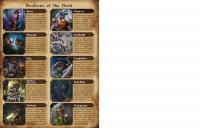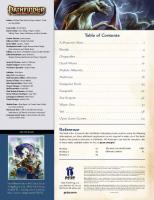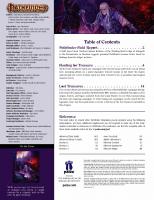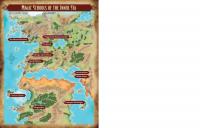Pathfinder Campaign Setting: Demons Revisited 9781601255525
Lords of Sin Demons have plagued heroes since the dawn of time. They are legion, as varied as the countless mortal sins
450 165 14MB
English Pages 68 Year 2013
Recommend Papers

- Author / Uploaded
- James Jacobs
File loading please wait...
Citation preview
Blood Demon
Serpent Demon
Spawned from the soul
Only the proudest and
of a murderer, the babau
most arrogant of cruel
personifies a very specific
kings, sadistic generals,
sin-the taking of
and violent warlords
pleasure from artistically
can fuel the birth of a
executed slaughter.
marilith with her soul.
Fire Demon No single mortal soul
The dread nabasu is
can fuel the birth of a
birthed directly into the
balor-these mightiest of
mortal realm, where it
demons form only from
gorges on the living, a
multiple souls of black
gruesome embodiment of
hearted dastards.
ravenous gluttony.
Treachery Demon
Greed Demon
Ferocious and bestial in
Self-appointed guardians
form, the silver-tongued
of the Abyss, the bloated
glabrezu, risen from
nalfeshnees rise from
the treacherous souls
the souls of avaricious
of traitors and liars, is a
mortals-bandits, thieves,
master of lies.
extorters, and kings alike.
Toad Demon
Lust Demon
Spawned from the souls
As beautiful as she is
of those who in mortal
deadly, the succubus
life polluted the land
is the most insidious
and poisoned the body,
of demons-the very
the hezrou is among the
quintessence of mortals'
foulest of demonkind.
darkest desires.
The envious invidiak
The vrock is a living
lacks what it lusts for
embodiment of rage and
most-physicality. Only
violence, a grotesque
by possessing a mortal
eidolon of humanity
can it revel in that which
birthed from mortals'
it covets so dear: life.
capacity for wrath.
Author• James Jacobs Cover Artist• Jesper Ejsing Interior Artists• Alberto Dal Lago, Vincent Devault, Mattias Fahlberg, Fabio Garia, Damien Mammoliti, Nikola Matkovic, Mark Molnar, Ryan Portillo, and Mariana Vieria Creative Director• James Jacobs Editor-in-Chief• F. Wesley Schneider
Table of Contents
Senior Editor• James L. Sutter Development Lead• James L. Sutter DevelopmentTeam• Logan Bonner, John Compton, Adam Daigle, Rob McCreary, Mark Moreland, and Patrick Renie Editorial Team• Judy Bauer, Christopher Carey,
Dealing with Demons ..........................2 Babau....................................... 4
and Ryan Macklin Editorial Interns• Jay Loomis and Cassidy Werner Lead Designer• Jason Bulmahn DesignTeam• Stephen Radney-MacFarland and Sean K Reynolds Senior Art Director• Sarah E. Robinson Art Director• Andrew Vallas
Balor .......................................10 Glabrezu ...................................16 Hezrou ....................................22
Graphic Designer• Sonja Morris Production Specialist• Crystal Frasier
lnvidiak................................... 28
Publisher• Erik Mona Paizo CEO • Lisa Stevens Chief Operations Officer• Jeffrey Alvarez Director of Sales• Pierce Watters Sales Associate • Cosmo Eisele
Marilith .................................. 34 Nabasu................................... 40
Marketing Director• Jenny Bendel Finance Manager• Christopher Self Staff Accountant• Kunji Seda ChiefTechnical Officer• Vic Wertz Senior Software Developer• Gary Teter
Nalfeshnee................................. 46 Succubus...................................52
Campaign Coordinator• Mike Brock Project Manager• Jessica Price Licensing Coordinator• Michael Kenway
Vrock .................................... 58
Customer Service Team• Erik Keith, Justin Riddler, and Sara Marie Teter Warehouse Team• Will Chase, Heather Payne, Jeff Strand, and Kevin Underwood Website Team• Ross Byers, Liz Courts, Lissa Guillet, and Chris Lambertz
Reference This book refers to several other Pathfinder Roleplaying Game products using the following abbreviations, yet these additional supplements are not required to make use of this book. Readers interested in references to Pathfinder RPG hardcovers can find the complete rules of these books available online for free at APG
Advanced Player's Guide
paizo.com/prd. Inner Seo Magic Ultimate Combat
Lords of Chaos: Book of the Damned, Vol. 2
BOTD2
Ultimate Magic
I SM UC UM
This product is compliant with the Open Game Ucense (OGL) and is suitable for use with the Pathfinder Roleplaying Game or the 3.5 edition of the world's oldest fantasy roleplaying game.
Product Identity: The following items are hereby identified as
Product Identity, as defined in the Open Game License
version i.oa, Section i(e), and are not Open Content: All trademarks, registered trademarks, proper names (characters, deities, etc.), dialogue, plots, storylines, locations, characters, artwork, and trade dress. (Elements that have previously been designated as Open Game Content or are in the public domain are not included in this declaration.)
Open Content:
Except for material designated as Product Identity (see above), the game mechanics of this Paizo
Publishing game product are Open Game Content, as defined in the Open Gaming License version i.oa Section 1(d). No portion of this work other than the material designated as Open Game Content may be reproduced in any form
Paizo Publishing, LLC 7120 i85th Ave NE, Ste no Redmond, WA 98052-0577
without written permission.
PothfinderCompoi9n Setting: Demons Revisited© 2013, Paizo Publishing, LLC.All Rights Reserved. Paizo, Paizo Publishing, LLC, the Paizo golem logo, Pathfinder, Pathfinder Society, and GameMastery are registered trademarks of Paizo Publishing, LLC; Pathfinder Adventure Card Game, Pathfinder Adventure Path, Pathfinder Campaign Setting, Pathfinder Cards, Pathfinder Flip-Mat, Pathfinder Map Pack, Pathfinder Module, Pathfinder Pawns, Pathfinder Player Companion, Pathfinder Roleplaying Game, Pathfinder Tales, and Rise of the Runelords are trademarks of Paizo Publishing, LLC.
paizo.com
Printed in China.
"·�� PATHFINDER CAMPAIGN XETTINfi: DEMONS �EVISITED
V
emons have existed for as long as humanity has dared wonder about what lies beyond mortal realms. Embodiments of sin, metaphors for religion, and foes to defeat, demons have been a part of the roleplaying gaming tradition from the start. Yet their presence in popular culture certainly doesn't stop at RPGs-they are the antagonists of some of the most successful (and notorious) horror movies (such as The Exorcist, The Evil Dead, Hellraiser, Sinister, Paranormal Activity) and video games (such as Devil May Cry, Doom, and Dra.!Jon A.!Je) of all time, and stories featuring the demonic fill bookstore shelves. Of course, in non-Pathfinder entertainment, the difference between demons and devils becomes largely semantic, but even so, demons are popular bad guys these days! In Pathfinder, demons are a specific type of fiend from the Abyss-outsiders formed from the unholy synthesis of sinful mortal souls and the raw matter of the Abyss itsel£ They make great villains for adventures, either as minions summoned by the corrupt, or as the masterminds behind vile cults and evil conjurers. This book examines 10 of the most common and notorious demons to plague the world of Golarion, and provides aid not only in incorporating them into your own tales of demonic adventure, but in teaching valuable lessons to those characters foolhardy enough to think themselves the masters of their demonic "servants."
�t'ttjucitt@ �ttnt'tt�
Numerous options exist for those foolish or brave enough to summon demons from the Abyss to do their bidding. The various summon monster spells bring lesser demons to serve in battle or for other short tasks, but the true conjurer instead relies upon spells such as planar ally or planar bindin.fJ, or for the truly powerful, .fjate. Although these more powerful spells, like the less powerful summoning effects, allow the spellcaster to conjure up standard members of each type of demon, their true potential lies in the fact that, if a demon's name is known and a proper offering is granted, the spellcaster may conjure up and traffic with specific and unique demons (often of great power). Note that, for the purposes of this book, the term "summoning" always refers to temporarily conjuring a demon (such as via a summon monster spell)-these demons are not individuals, but rather magical "duplicates" created by the interaction of spell energy and the Abyss, which exist only until their deaths or the end of the spell. "Calling," on the other hand, refers to spells like planar ally or .fjate that bring an individual demon through to the caster's plane permanently-these demons do not
disappear when slain or at the end of a spell, and have their own lives and opinions, making calling them both more useful and more dangerous. Learning a Demon's Name: A spellcaster can learn a demon's name in numerous ways. One may learn it from the demon itself, through discussion with other spellcasters, or by reading another demonologist's notes. The name may come to the seeker in visions or dreams. A curious spellcaster may attempt to research a particular type of demonic name by spending time in a library with a significant number of tomes on demonology (it's up to the GM to decide whether any one library can be used for this type of research). Typically a spellcaster begins his search with a specific service in mind-he might be seeking a demon to build a powerful weapon for him, to learn a particular secret about a competing spellcaster, or to combat good outsiders. The GM selects an appropriate demon (either one from this book, or one ofher own design) to fulfill that requirement. An attempt to research a specific demon to complete such a task takes a full day of study and requires a Knowledge (planes) check with a DC equal to 10 + the researched demon's CR. Note that these names are not true names-discovery of a demon's true name is a much more time-consuming and difficult procedure, but it grants great benefits to the conjuring spellcaster. See pages 101-102 of the Pathfinder RPG GameMastery Guide for more details on true names. Using a true name when conjuring a specific demon allows the conjurer to ignore the additional offering required when conjuring the demon. Researching the Demon's Desires: Once the target demon is known, the spellcaster must incorporate the demon's name, written in Abyssal, into a magic circle inscribed upon a solid surface using inks made from powdered cold iron. A spellcaster may simply use powdered cold iron, but runs the risk of a gust of wind or careless foot breaking the circle. Permanent cold iron inlays are the most effective means of creating such circles, but have the disadvantage of not being portable. Before the spell used to conjure the demon is cast, an offering meeting the specific demon's desires must be placed in the circle and must remain in that circle for the duration of the casting of the spell. Determining an appropriate offering requires a day of research in a proper library and a Knowledge (planes) check (DC 10 + the demon's CR), and procuring it can be difficult and time-consuming, or even dangerous and illegal. Use the offerings for numerous demons found later in this book as examples when designing new offerings for unique demons of your own design. (Note that these offerings are intended =
to be descriptive-while individual demons may certainly demand specific offerings and payments, all spells still function mechanically as described in the standard rules, and a caster may still conjure a generic demon even if he or she doesn't have the specific offerings outlined for a demon of that type. In these cases, the demon conjured is likely to be even angrier than normal about its service.) Conjuring the Demon: Once the above information is obtained, the spellcaster need only cast the appropriate conjuration spell to make contact with the demon. Each of the chapters in this book presents a number of named demons, along with the Knowledge (planes) DCs to learn their names and preferred offerings. All of the named and unique demons detailed in these sections have more than 12 Hit Dice, and thus require at minimum a 11reater planar ally or 11reater planar bindinlJ to conjure them. Many of them have more than 18 Hit Dice, in which case a11ate spell or other powerful method of conjuring outsiders must be employed. If 13ate is required to conjure the demon, a superscript G (G) follows the demon's research DC. Several of the named demons in this book are drawn from adventures or other products published by Paizo-in such cases, the reference for the demon's original appearance in print are listed. (If you wish to avoid spoilers for a particular adventure, make sure to take note of where the demon originally appeared before reading that entry!) If one of these demons is slain in your campaign, it can no longer be conjured for service unless a powerful spellcaster uses true resurrection to restore it to life.
tJalj-�ttnOtttl
The versatile half-fiend template (see page 71 of the Pathfinder RPG Bestiary) can be applied to any living, corporeal creature. While demons themselves do not rely upon reproduction to keep up their numbers, most demons can impregnate mortal creatures or, in some cases, can become pregnant with half-mortal offspring themselves. (See the individual chapters for specific information on this topic.) Of course, other methods can generate half-fiends as well-exposure to fecund Abyssal magic and energy, powerful ancient curses, and certain vile and blasphemous rituals may create half-fiend creatures-but demons in particular among the fiendish races are particularly and horrifically compatible with mortal humanoids. When a demon breeds with a mortal humanoid, the resulting birth is often a specific sub-category of half-fiend-a half-demon. Certain rituals can ensure that the resulting child is a half-demon rather than a half-fiend: such rituals are common in certain demon worshiping cults, and some demons seek to sire or birth such children for their own sinister purposes. A half-demon's statistics are generated as if they were half-fiends, save for some modifications dependent on
the type of its demonic parentage. The majority of half-. demons are chaotic evil. Each of the following chapters presents adjustments to the half-fiend template when generating a specific half-demon; you can use these 10 examples to generate new half-demon templates for demons not detailed in this book. If an element of the half-fiend template is not mentioned in a particular half-. demon sidebar, that element is not adjusted. Almost all half-demons are half-humanoids. It's exceptionally rare for a non-humanoid to gain this template-most such situations result in a typical half fiend. While tieflings-humanoids with a smattering of fiendish blood-may trace their lineage back to such a union, true half-demons are far rarer and more powerful than their watered-down descendants.
rJTiott �ttnOtttl
This book provides extensive details on 10 types of demons (11, if you include the vrolikai, the mature version of a nabasu), but there are far more demons in the Abyss. The sins of the mortal mind and soul are legion and in the Abyss, there are worlds of difference between even those sins that seem similar to mortals-murderous sins result in different demons than those burdened with assassinations or regicide, for example. Note that another category of demons exists beyond the standard of their kind-mythic demons. These demons are more powerful incarnations of standard demons that have been granted or have stolen some legendary source of power or are otherwise a step above others of their kind. Several sample mythic demons are presented in Pathfinder RPG Mythic Adventures-more doubtless exist than those detailed in that book's pages, but mythic demons are incredibly rare and unusual cases even among the fecundity of the Abyss.
,:!: PATHFINDER CAMPAIGN XETTINfi: DEMONS �EVISITED
T
.. be igl]otal]t call babaus "bloob bemolJS fot tbe ctimsol] gote tbat seeps ftom
tbeit flesb al]b bdps ftom tbeit ftames. yet lJOl]e wbo bave erpedel]ceb a
babaus catess mista�e tbis fluib fot bloob. Mote ptopedy. befittil]g tbeit violel]t l]atutes al]b mutbetous gel]esis. tbe l]ame "bloob bemolJ" bedves ftom tbese cteatutes· folJbl]ess fot tbe fluib wbelJ btawl] ft om tbeit victims. Tbe babau boesl]'t bdlJ� tbe bloob li�e tbe vampite. l]Ot btaw upolJ its powet li�e tbe bemotbeutge. It metely el]joys tbe wet watmtb of life flowil]g ftom al] ilJlJOCel]t. To a babau. bloob is tbe ultimate siglJ of pleasute. -Ftom tbe Boob oftbe Dan]l]eb
f
or ages, the souls of murderers consigned to the Abyss gave rise to demons associated with the sins that drove them to murder, not to a specific demon associated with the act of murder itself. Murderers compelled to their vile acts out of anger became vrocks, those driven by jealousy became invidiaks, those fueled by greed became nalfeshnees, and so on. But Shax, the Blood Marquis of Charnelhome, saw within the act of murder a unique flavor of sin, and when he took the 100 most vile larvae formed from murderous souls and inflicted upon them the same torments they had wrought on their victims, the demon lord created an entirely new race of demon-the babau. As when the first demons were formed from the interaction of mortal sins, Abyssal energies, and protomatter, the Abyss itself learned this new pattern. New babaus formed from murderous souls with ever increasing frequency, much to Shax's delight and pride. While the most powerful babaus, known as the Sons of Shax, are still "hand-crafted" by the demon lord of murder, the Abyss also spawns its own fresh babaus to fill the limitless ranks of demonkind. In time, specific types of murderers, such as assassins or child-killers or jealous lovers, would spawn their own kinds of demons-yet the majority of murderous souls continue to spawn babaus, and today they are among the most common demon types found in the Abyss or elsewhere. The bulk of the babau race serves Shax, toiling in his city-sized palace of Charnelhome to keep the countless deathtraps that fill that structure running and in good repair. A fair number of these traps require some level of direct interaction in order to function, while some even use babau life forces to power their insidious machinations. Babaus can also be found in the armies of most of the demon lords of the Abyss, where they typically serve as commanders of lesser demons like dretches and brimoraks, or as infantry themselves under the command of vrocks or more powerful demons. Babaus themselves prefer to serve no master, and given the choice spend their time either murdering fresh victims or lying in wait, entertaining themselves with mental exercises in which they devise new methods of killing. The babau is generally not all that interested in luring mortals into committing murder, and so does relatively little to perpetuate the creation of its own kind. Fortunately for the babau race (and unfortunately for mortals), murderers are never in short supply. And while babaus themselves slay a large number of mortals, their preference for innocent or kind-hearted victims tends to skew the souls of their victims toward other final rewards than transformation into Abyssal larvae. Some sages postulate that the babau's disinterest in providing the Abyss with new sinful souls accounts for the demons'
relative lack of power, yet these same sages are at a loss to explain the vast numbers of new babaus constantly forming in the Outer Rifts.
�ft1�iolos�
As with most demons, the babau has a generally humanoid shape. The demon's three most identifiable features are its gauntness, the long hooklike horn that protrudes from the back of its head, and the glistening layer of crimson slime that coats its body. The crimson slime is produced much in the same way as mortal sweat, yet the babau does not excrete it as a result of exertion or overheating. Rather, the thick, bloodlike slime seems to flow from its pores most swiftly in the hours after a fresh kill. Whether it is a natural byproduct of the creature's supernatural excitement from the murder or something else is unclear, but as any adventurer who has faced a babau can vouch, the acidic slime is quite painful to the touch, and any creature that strikes a babau puts its weapons at risk. Babau slime does not dry, regardless of how long it sits in the hottest and most arid of environments. Deposits dripped from a babau's frame or harvested by curious scholars persist for some time, slowly diminishing in amount in a process similar to evaporation that eventually leaves no trace behind. The slime retains its corrosive qualities until it vanishes, and a vial of the slime thrown as a splash weapon functions identically to a vial of acid, but those who seek babau slime typically do so for other, more nefarious purposes. The stuff can be used as a reagent for all manner of magical items that utilize acidic or demonic features. For example, it can be a significant ingredient in the creation of advanced mandragoras, although in such cases, the mandragora pods must be "incubated" in the corpse of a babau rather than in blighted soil. Concentrated babau slime can even be treated and refined into a potent toxin when mixed with contact poisons like black lotus extract, dragon bile, malyass root paste, nitharit, sassone leaf residue, tears of death, or terinav root. Combining a dose of the slime with a contact poison requires a day's work, l,ooo gp in alchemical supplies, and a successful Craft (alchemy) check with a DC equal to 10 + the contact poison's save DC. The resulting paste can coat a small object or patch no larger than the width of a human hand, but it dries quickly and clearly. In addition to any effects caused by contact with the poison, it inflicts 2d8 acid damage for 2 rounds after it is touched. The slime does not seem to harm anything it's been allowed to dry on; the acidic damage only affects creatures or objects used to touch it after the fact. Beyond the acidic slime that coats it and its demonic appearance, the babau's body is strange in other ways.
"·�� PATHFINDER CAMPAIGN XETTINfi: DEMONS �EVISITED
HALF-BABAU A
h a l f- b a b a u is skeleta l l y t h i n , ofte n with poi nted ea rs a n d a s i n g l e horn- l i ke g rowth c u rl i n g up fro m its s ku l l . Its s k i n tone tends to be dark red, a n d the creatu re's jaws a re f i l l e d with sha rp, jagged teeth. They ofte n beco me mass m u rd e re rs, serial k i l l e rs, o r s i m p l y sadistic m e rce n a ries o r s o l d i e rs. Speed: A half-ba bau does not gain a fly speed. Acidic Blood (Su) A creature that attacks a ha lf-babau with a piercing o r slashing natura l attack takes 1 d 4 poi nts of acid damage. Sneak Attack Expert (Ex) : A ha lf- b a b a u i n sti nctive l y knows how to stri ke f o e s to maxim ize p a i n a n d a g o ny a n d g a i n s sneak attack + 1 d 6 . This a b i l ity stacks with sneak attack g a i ned fro m other sources. Alternate Spell-Like Abilities: Replace desecrate with see invisibility. Replace contagion with keen edge. Replace unhallow with greater teleport. Replace horrid wilting with acid fog 3/day. Abilities: A half-babau gains Str +4, Dex +2, Con +4, Int +2, Wis +2, and Cha +2.
While the babau's skin is flexible as human flesh, it is supernaturally tough. The creatures are completely hairless, and even without the coating of slime their skin feels unnaturally smooth to the touch. Their muscles and internal organs seem atrophied-in some places, apparently to the point of dissolution-yet they function better than those found in most mortal creatures. The demon's emaciated frame should not be taken as an indication of physical weakness or starvation, for the typical babau is strong enough to smash through a wooden door with ease.
�tmonolos!
The leaders of demonic cults value babaus primarily for their capacity to serve as guardians. A babau is rarely encountered as a cult leader-as a general rule, these demons are too fond of murder to be able to keep anything resembling a following for long, for when forced to go without a victim, a babau cult leader invariably turns to its hapless minions to sate its bloodlust. Far more often, they are encountered as guardians or minions of cult leaders or demonologists, or in regions like the Worldwound or Tanglebriar in larger groups of roving patrollers. A babau can be summoned via summon monster V, but utilizing higher level summon monster spells to summon multiple babaus is generally a stronger option, as multiple babaus are adept at working together to flank foes and inflict significant sneak attack damage upon them. Although they loathe being summoned
for uses other than combat, babaus' ability to use dispel magic at will makes them excellent choices when faced with undesirable magical effects or traps. The demon's relatively low caster level, compared to the caster level of a spellcaster capable of summoning them in the first place, is more than ameliorated by the fact that the demon can attempt new dispellings each round for the duration of its stay. Ordering a summoned babau to prepare an action to dispel any harmful magical effect that targets you, either via counterspelling as the enemy spell is cast or, more traditionally, once the effect takes place, is an excellent use of this demon's spell-like ability. To call a babau, the spellcaster must employ planar ally, planar binding, or more powerful magic. When utilizing planar ally or other spells that require costly material components, the components must consist of a combination of rare incense, poisonous herbs, a vial of murderer's blood, and valuables looted from an intelligent creature murdered by the spellcaster no less than a week prior. A typical babau prefers an offering of a living and intelligent creature to murder, either bound and helpless within the magical circle into which the demon is to be summoned, or else offered as an additional reward once the demon agrees to perform a service for the spellcaster. Such offerings have a gp equivalent of 100 gp per HD of the offering for the purposes of payments to the babau for services rendered-this equivalent is doubled if the offering is lawful good, or tripled if the offering is an outsider with both the Lawful and Good subtypes. If the magic circle does not include the blood of a murder victim, then candles made from the fat of a murder victim must be placed at the seven points of the circle itself. Alternately, murdering an intelligent creature as part of the spell's casting and placing the warm blood of the victim in a metal (not cold iron! ) bowl that is then placed within the magic circle before the demon's arrival suffices to fill this requirement. Care must be taken that the spilled blood does not flow over the borders of the magic circle, though, lest it enable the babau to escape once conjured. Few babaus that escape a spellcaster in this manner turn on the spellcaster, for they know that a spellcaster capable of summoning one of their ilk is likely quite powerful. Instead, these babaus use greater teleport to flee the immediate area if they can, so as to take advantage of their unexpected freedom.
�ampaisn









